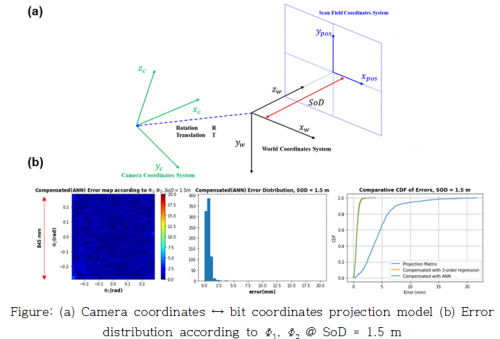Major research outcome
- Ph.D. Candidate Mu-Seung Jeon and Professor Jung-Ryul Lee, Development of real-time in-situ laser targeting algorithm using a 3D-LiDAR camera
- 관리자 |
- 2024-09-11 14:59:34|
- 182
- 2024-09-11 14:59:34|
Galavanometric Laser Scanner (GLS) uses two galvanometers to steer lasers, offering high repeatability, affordability, and high resolution. It is widely used in various fields such as medical applications, 3D metal printin and non-destructive testing. However, geometric configurations of galvanometers can introduce pincushion distortion, and inherent inaccuracies in the equipment itself pose challenges in precisely targeting lasers. Traditionally conducted calibration research has been limited to fixed working distances, rendering it inapplicable in situations with varying operational ranges.
Recently, Ph.D. Candidate Mu-Seung Jeon and Professor Jung-Ryul Lee have studied to develop a targeting algorithm that utilizes 3D coordinates obtained from 3D LiDAR to direct lasers through a GLS system. Under approximate conditions, they linearized the steering formula and transformed the 3D coordinates into 2D bit coordinates for the GLS control board. They compensated for nonlinear errors using third-order power series regression and artificial neural networks. This approach enabled them to steer lasers within an average targeting error of 0.6 mm across distances from 0.5 m to 2 m, and showed an average error of 1.2 mm at 2.5 m. The related paper has been accepted in Optics and Lasers in Engineering, volume 183, in 2024, which covers techniques in optics, lasers, and applied optics (Optics JCI Q1 16.25%).
https://doi.org/10.1016/j.optlaseng.2024.108542
Recently, Ph.D. Candidate Mu-Seung Jeon and Professor Jung-Ryul Lee have studied to develop a targeting algorithm that utilizes 3D coordinates obtained from 3D LiDAR to direct lasers through a GLS system. Under approximate conditions, they linearized the steering formula and transformed the 3D coordinates into 2D bit coordinates for the GLS control board. They compensated for nonlinear errors using third-order power series regression and artificial neural networks. This approach enabled them to steer lasers within an average targeting error of 0.6 mm across distances from 0.5 m to 2 m, and showed an average error of 1.2 mm at 2.5 m. The related paper has been accepted in Optics and Lasers in Engineering, volume 183, in 2024, which covers techniques in optics, lasers, and applied optics (Optics JCI Q1 16.25%).
https://doi.org/10.1016/j.optlaseng.2024.108542
| Attach File |
|---|


